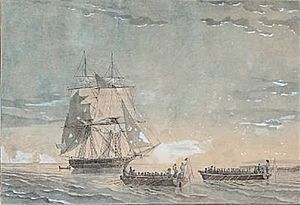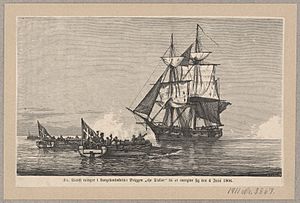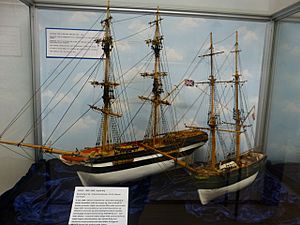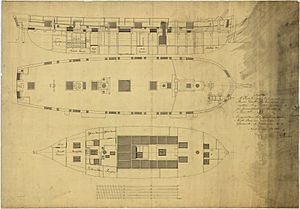HMS Tickler (1804) facts for kids

C. Wulff capturing Tickler, 1808; Niels Truslew
|
|
Quick facts for kids History |
|
|---|---|
| Name | HMS Tickler |
| Ordered | 22 March 1804 |
| Builder | Matthew Warren, Brightlingsea |
| Laid down | May 1804 |
| Launched | 8 August 1804 |
| Captured | 4 June 1808 |
| Name | HDMS De Teichler |
| Acquired | 1808 by capture |
| Renamed | Frederikke Louise (1815) |
| Captured | 9 June 1808 |
| Fate |
|
| General characteristics | |
| Class and type | Archer-class gunbrig |
| Tons burthen | 17877⁄94 (bm) |
| Length |
|
| Beam | 22 ft 7 in (6.9 m) |
| Depth of hold | 9 ft 5 in (2.9 m) |
| Complement | 50 |
| Armament | 10 × 18-pounder carronades + 2 chase guns |
HMS Tickler was a small but strong warship called a gunbrig. She was built in England in 1804. A gunbrig was a type of sailing ship armed with many cannons. Tickler served the British Navy in the English Channel and the Baltic Sea. In 1808, during the Gunboat War, Danish forces captured her. After being captured, she was sold in 1815. From 1815 to 1852, she sailed under the name Frederikke Louise. She first worked as a merchant ship, carrying goods. Later, from 1843 to 1851, she became a ship used for seal hunting.
Contents
Life as a British Warship
HMS Tickler began her service in August 1804. Lieutenant Charles Irvine was her first commander. Later, Lieutenant John Watson Skinner took command.
In January 1805, Tickler played a small but important role. She brought a French officer to England. This officer was carrying a secret message from a French leader named Talleyrand to a British leader, Lord Harrowby. The message was very urgent and had traveled quickly from Paris.
Fighting French Ships
On April 24, 1805, Tickler was part of a group of British warships. They were sailing near Cap Gris Nez in France. The British ships spotted 26 French vessels. These French ships were trying to sneak past.
The British commander ordered his ships, including Tickler, to stop them. After about two hours of fighting, two British ships, Starling and Locust, managed to capture seven of the French vessels. These French ships were called schuyts. They were small boats carrying soldiers and sailors. The French convoy was heading from Dunkirk to Ambleteuse. Only one British sailor was hurt during this fight.
The captured French schuyts were:
- Schuyt No. 52, armed with three large cannons.
- Schuyt No. 48, armed with two small cannons, one large cannon, and a brass howitzer.
- Schuyt No. 57, armed with one large cannon and two small cannons.
- Schuyt No. 45, a transport ship, armed with one large cannon, one medium cannon, and one small cannon.
- Schuyt No. 3, whose commander escaped before it was captured.
- Schuyt No. 54, armed with one large cannon and two small cannons.
- Schuyt No.43, armed with one large cannon and two small cannons.
The next day, two more French schuyts (No.s 44 and 58) were captured. Each of these had one large cannon and two medium cannons. The British ships towed the captured French vessels back to England.
More Duties and Encounters
In August 1807, Tickler helped to stop a ship named Hausstind. Later, in September, she stopped two more ships, Justicia and Juckinthat, that were sailing from Norway.
In October, Tickler arrived in Elsinore, Denmark, with a group of other ships. On December 14, 1807, another British ship, HMS Astraea, captured a French privateer (a privately owned warship) called Providence. Tickler was nearby and helped in the chase.
Capture by the Danes
On June 3, 1808, Tickler was sailing in a strait called the Great Belt. She met two Danish gunboats. After fighting for 45 minutes, the Danish boats pulled back.
The next day, June 4, the two Danish gunboats were still nearby. Four more Danish gunboats appeared and started rowing towards Tickler. There was no wind, which made it hard for Tickler to move. This gave the smaller, oar-powered Danish gunboats a big advantage.
The four Danish gunboats began firing at 2:45 p.m. Tickler fired back with her front cannons. Early in the battle, Lieutenant Skinner was hit in the head and died. Sub-Lieutenant James Sheppheard then took command. At 7:15 p.m., Sheppheard had to surrender. This is called striking the colours.
Tickler had one sailor killed and seven wounded. Her hull (the main body of the ship) was full of holes, and her rigging (the ropes and sails) was badly damaged. The Danish gunboats, led by Lieutenant Christian Wulff, had very few injuries.
Life as a Danish Ship
After her capture, the Danes called Tickler "Den erobrede engelske Brig Tiechler," which means "the captured English brig Tiechler." The Danish Navy kept her until 1815, when they sold her.
From 1815 to 1842, she became a merchant ship in Copenhagen. Her new name was Frederikke Louise. She was listed in a shipping record book called Lloyd's Register from 1839. It showed she was a British-built ship of 164 tons.
| Year | Master | Owner | Trade | Source & notes |
|---|---|---|---|---|
| 1839 | A.Bohintz | CH Smith | "Gns."–Cette | LR; large repair 1837 |
In 1842, Frederikke Louise was sold to a company in Rønne, Bornholm. They changed her into a ship for seal hunting in the "northern ice sea." She was used for seal hunting from 1842 to 1851.
Here's how many seals and walruses she helped catch:
| Year | Seals | Walruses | Other |
|---|---|---|---|
| 1843 | 1700 | ||
| 1844 | 1700 | 6 | |
| 1845 | 840 | 1 | |
| 1846 | 2350 | 58 barrels of blubber | |
| 1847 | 3600 | ||
| 1848 | Not available | ||
| 1849 | 3030 | 84 barrels of blubber | |
| 1850 | 3490 | ||
| 1851 | 5600 | 148 barrels of blubber |




